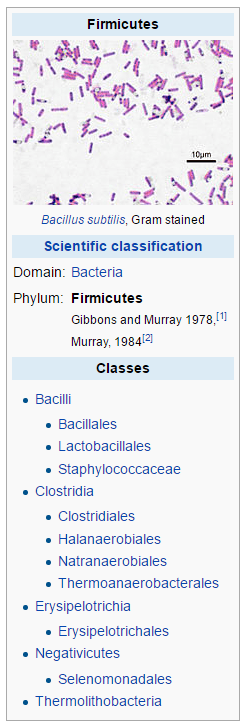This week there was a new study published “Reduced diversity and altered composition of the gut microbiome in individuals with myalgic encephalomyelitis/chronic fatigue syndrome.” Jun 23, 2016. [Full Text]
“We observed that bacterial diversity was decreased in the ME/CFS specimens compared to controls, in particular, a reduction in the relative abundance and diversity of members belonging to the Firmicutes phylum. In the patient cohort, we find less diversity as well as increases in specific species often reported to be pro-inflammatory species and reduction in species frequently described as anti-inflammatory. Using a machine learning approach trained on the data obtained from 16S rRNA and inflammatory markers, individuals were classified correctly as ME/CFS with a cross-validation accuracy of 82.93 %.”

- “Both found that D-lactic acid-producing Enterococcus andStreptococcus species were strongly over-represented in ME/CFS patients and that among anaerobic bacteria, Prevotella was a bacterial genus found to be in excess in subjects with ME/CFS.”
Of course, the reader will likely ask – What are the Firmicutes? Check out Wikipedia or see image below.

Of course, 18 years ago this was reported in Australia at the 1998 Alison Hunter Memorial Clinical and Scientific Meeting. “For the anaerobes, the mean percentage distribution of Bacteroides spp. for the control subjects and CFS patients was 92.8% and 91% respectively; Bifidobacterium spp, 7.1% and 2%; Lactobacillus spp., < 1% and 0%.”
In 2009 Sheedy, reported the overgrowth of d-lactic producing bacteria in CFS/ME patients and states ” Given the fact that this might explain not only neurocognitive dysfunction in CFS patients but also mitochondrial dysfunction, these findings may have important clinical implications.” That is two major set of symptoms come from the bacteria shift.
In 2013, by Kenny De Meirleir “A highly significant separation could be achieved between Norwegian controls and Norwegian patients: patients presented increased proportions of Lactonifactor and Alistipes, as well as a decrease in several Firmicutes populations”
As well as difference seen with exercise reported in 2015, ” Upon exercise challenge, there were significant changes in the abundance of major bacterial phyla in the gut in ME/CFS patients not observed in healthy controls.”

- “Of note is the significant increase in the relative abundance of Bacilli in blood samples collected from ME/CFS patients at the 48 hour time point. We also observed rapid changes in the relative abundances of the Clostridium XIVa and IV clusters, belonging to the phylum Firmicutes, in blood samples collected 15 min after maximal exercise from ME/CFS patients, but not healthy controls (Fig 3).”
The Awkaward Questions for Physicians and Researchers
With this information being known for 18 years and multiple specialized probiotics being effective for IBS (see this post for the literature), why are there no published studies on the use of the IBS successful probiotics on CFS/ME?
My model is in 100% agreement with this study, this site attempts to read the literature, find good candidate probiotics, herbs and even antibiotics and suggest them. They worked for me and have worked for a number of readers – especially one that was almost wheel chair bound in Spain a year ago — who just messaged me that she spent the entire day cleaning the house — spotless. Her 3rd day of working all day long without payback.
There was another study (not CFS/ME) that found 93% accuracy for multiple conditions from microbiome samples… a k a stool samples.
